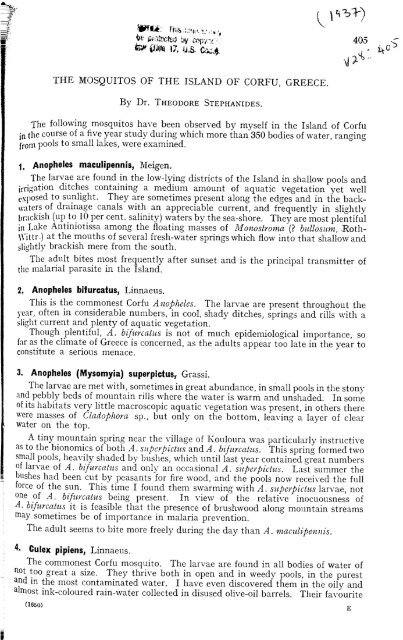The mosquitoes of the island of Corfu Greece.
The mosquitoes of the island of Corfu Greece.
The mosquitoes of the island of Corfu Greece.
You also want an ePaper? Increase the reach of your titles
YUMPU automatically turns print PDFs into web optimized ePapers that Google loves.
THE MOSQUITOS OF THE ISLAND OF CORFU, GREECE.<br />
By Dr. THEODORE<br />
STEPHANIDES.<br />
<strong>The</strong> following mosquitos have been observed by myself in <strong>the</strong> Island <strong>of</strong> <strong>Corfu</strong><br />
in tile course <strong>of</strong> a five year study durin, u which more than 350 bodies <strong>of</strong> water, ranging<br />
from pools to small lakes, were examined.<br />
1, Anopheles maculipennis, Meigen.<br />
<strong>The</strong> larvae are found in <strong>the</strong> low-lying districts <strong>of</strong> <strong>the</strong> Island in shallow pools and<br />
irrigation ditches containing a medium amount <strong>of</strong> aquatic vegetation yet well<br />
c,IjOsed to sunlight. <strong>The</strong>y are sometimes present along <strong>the</strong> edges and in <strong>the</strong> back-<br />
,v;lters <strong>of</strong> drainage canals with an appreciable current, and frequently in slightly<br />
i,rnckish (up to 10 per cent. salinity) waters by <strong>the</strong> sea-shore. <strong>The</strong>y are most plentiful<br />
irl Lake Antiniotissa among <strong>the</strong> floating masses <strong>of</strong> Monostromn (? b~dlostcm, .Roth-<br />
\\‘ittr.) at <strong>the</strong> mouths <strong>of</strong> several fresh-water springs which flow into that shallow and<br />
sliglltly brackish mere from <strong>the</strong> south.<br />
<strong>The</strong> adult bites most frequently after sunset and is <strong>the</strong> principal transmitter <strong>of</strong><br />
t\lc malarial parasite in <strong>the</strong> Island.<br />
2. Anopheles bifurcatus, Linnaeus.<br />
This is <strong>the</strong> commonest <strong>Corfu</strong> A~zo~heZes. <strong>The</strong> larvae are present throughout <strong>the</strong><br />
~‘car, <strong>of</strong>ten in considerable numbers, in cool, shady ditches, springs and rills with a<br />
slight current and plenty <strong>of</strong> aquatic vegetation.<br />
Though plentiful, A. bifurcatus is not <strong>of</strong> much epidemiological importance, so<br />
far as <strong>the</strong> climate <strong>of</strong> <strong>Greece</strong> is concerned, as <strong>the</strong> adults appear too late in <strong>the</strong> year to<br />
constitute a serious menace.<br />
3. Anopheles (Mysomyia) superpictus, Grassi.<br />
<strong>The</strong> larvae are met with, sometimes in great abundance, in small pools in <strong>the</strong> stoq<br />
and pebbly beds <strong>of</strong> mountain rills where <strong>the</strong> water is warm and unshaded. In some<br />
<strong>of</strong> its habitats very little macroscopic aquatic vegetation was present, in o<strong>the</strong>rs <strong>the</strong>re<br />
ivere masses <strong>of</strong> Clndo@~orn sp., but only on <strong>the</strong> bottom, leaving a layer <strong>of</strong> clear<br />
water on <strong>the</strong> top.<br />
A tiny mountain spring near <strong>the</strong> village <strong>of</strong> Iiouloura was particularly instructive<br />
3s to <strong>the</strong> bionomics <strong>of</strong> both A. sz~~~~~icfz~s and A. bifurcatt~s. This spring formed two<br />
small pools, heavily shaded by bushes, which until last year contained great numbers<br />
<strong>of</strong> larvae <strong>of</strong> A. biftzrcntzls and only an occasional A. sz+@‘ctus. Last summer <strong>the</strong><br />
bushes had been cut by peasants for fire wood, and <strong>the</strong> pools now received <strong>the</strong> full<br />
force <strong>of</strong> <strong>the</strong> sun. This time I found <strong>the</strong>m swarming with A. sz@~Qktus larvae, not<br />
one <strong>of</strong> A. bifzucatus being present. In view <strong>of</strong> <strong>the</strong> relative inocuousness <strong>of</strong><br />
A. bifwcatw it is feasible that <strong>the</strong> presence <strong>of</strong> brushwood along mountain streams<br />
may sometimes be <strong>of</strong> importance in malaria prevention.<br />
<strong>The</strong> adult seems to bite more freely during <strong>the</strong> day than A. nzacdipewis.<br />
4. Culex pipiens, Linnaeus.<br />
<strong>The</strong> commonest <strong>Corfu</strong> mosquito. <strong>The</strong> larvae are found in all bodies <strong>of</strong> water <strong>of</strong><br />
not too great a size. <strong>The</strong>y thrive both in open and in weedy pools, in <strong>the</strong> purest<br />
and in <strong>the</strong> most contaminated water. I have even discovered <strong>the</strong>m in <strong>the</strong> oily and<br />
almost ink-coloured rain-water collected in disused olive-oil barrels. <strong>The</strong>ir favourite<br />
mm<br />
E
















